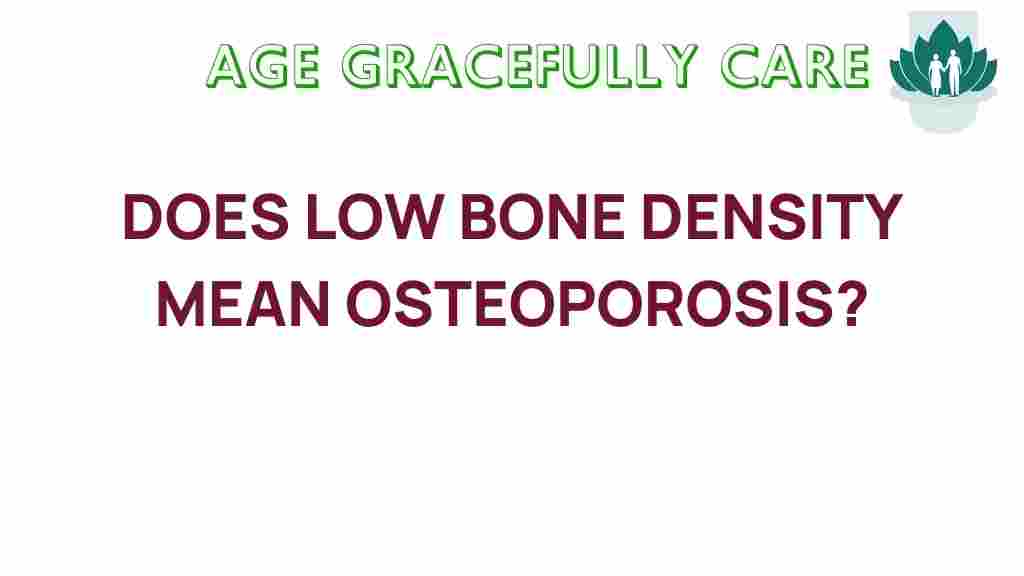Unraveling the Link: Does Low Bone Density Indicate Osteoporosis?
Bone health is a crucial aspect of overall well-being, particularly as we age. Many individuals may wonder about the connection between low bone density and osteoporosis. This article aims to unravel this link, providing insights into bone density, osteoporosis, risk factors, prevention strategies, diagnosis methods, and treatment options. Understanding these elements can empower you to take charge of your health and mitigate risks associated with osteoporosis.
Understanding Bone Density and Osteoporosis
Bone density refers to the amount of bone mineral in bone tissue, which is an essential measure of bone strength. Osteoporosis is a medical condition characterized by weak and brittle bones, making them more susceptible to fractures. The relationship between low bone density and osteoporosis is significant; low bone density is often a precursor to the development of this condition.
As we age, our bone density naturally decreases. Factors such as genetics, diet, lifestyle, and hormonal changes contribute to this decline. Therefore, it is vital to monitor bone density to assess the risk of osteoporosis, particularly in older adults.
Risk Factors for Low Bone Density and Osteoporosis
Several risk factors can contribute to low bone density and increase the likelihood of developing osteoporosis. These can be categorized into modifiable and non-modifiable factors:
- Non-modifiable Risk Factors:
- Age: Bone density typically decreases with age.
- Gender: Women are at a higher risk, especially post-menopause.
- Family History: A family history of osteoporosis can increase risk.
- Ethnicity: Caucasian and Asian descent are at greater risk.
- Modifiable Risk Factors:
- Diet: Low calcium and vitamin D intake can affect bone density.
- Lifestyle: Sedentary lifestyle and lack of weight-bearing exercises.
- Smoking: Tobacco use is known to weaken bones.
- Alcohol: Excessive alcohol consumption can negatively impact bone health.
- Certain Medications: Long-term use of corticosteroids can lead to bone loss.
Diagnosis of Low Bone Density and Osteoporosis
Diagnosing low bone density and osteoporosis typically involves several steps, including medical history evaluation, physical examination, and imaging tests. The most common diagnostic tool is a dual-energy X-ray absorptiometry (DXA) scan, which measures bone mineral density (BMD).
The results of the DXA scan are usually compared to a standard reference called the T-score:
- A T-score above -1 indicates normal bone density.
- A T-score between -1 and -2.5 indicates low bone density (osteopenia).
- A T-score of -2.5 or lower indicates osteoporosis.
Prevention of Low Bone Density and Osteoporosis
Preventing low bone density and osteoporosis is crucial, especially for those at higher risk. Here are several effective strategies:
- Nutrition: Ensure a diet rich in calcium and vitamin D. Foods such as dairy products, leafy greens, and fortified foods can help.
- Exercise: Engage in regular weight-bearing and strength-training exercises to enhance bone strength.
- Avoid Smoking and Limit Alcohol: These lifestyle changes can significantly reduce the risk of bone density loss.
- Regular Screenings: Get your bone density tested regularly, especially if you have risk factors for osteoporosis.
Treatment Options for Low Bone Density and Osteoporosis
If diagnosed with low bone density or osteoporosis, various treatment options are available. These treatments aim to strengthen bones and reduce the risk of fractures:
- Medications: Several medications can help manage osteoporosis, including bisphosphonates, hormone therapy, and selective estrogen receptor modulators (SERMs).
- Supplements: Calcium and vitamin D supplements may be recommended to support bone health.
- Lifestyle Modifications: Continuing with exercise and dietary changes is essential for effective treatment.
Age and Bone Health: A Closer Look
Age plays a critical role in bone density and osteoporosis risk. From early adulthood to old age, bone mass typically increases until it peaks around the age of 30. After this peak, bone density gradually declines, particularly in women during and after menopause due to hormonal changes.
Older adults are particularly vulnerable to osteoporosis; therefore, it is essential to start preventive measures early. Regular check-ups, maintaining a healthy lifestyle, and being proactive about bone health can dramatically affect outcomes as one ages.
Lifestyle Factors Influencing Bone Density
Your lifestyle choices significantly impact your bone density and overall health. Here are a few lifestyle factors to consider:
- Physical Activity: Aim for at least 30 minutes of moderate exercise most days of the week.
- Balanced Diet: Incorporate a variety of foods rich in calcium and vitamin D.
- Weight Management: Maintain a healthy weight to support bone health.
- Mental Health: Manage stress and engage in activities that promote mental well-being, as they can indirectly influence physical health.
Troubleshooting Tips for Maintaining Bone Health
Here are some troubleshooting tips to help maintain and improve bone density:
- If you have dietary restrictions, consider consulting a dietitian to ensure adequate calcium and vitamin D intake.
- Incorporate balance and flexibility exercises into your routine to reduce fall risk.
- Monitor your bone health with regular check-ups and discuss any concerns with your healthcare provider.
- Stay informed about new research and treatments related to osteoporosis and bone health.
Conclusion
Understanding the relationship between low bone density and osteoporosis is critical for maintaining bone health throughout life. By recognizing the risk factors, engaging in preventive measures, and seeking appropriate treatment, individuals can significantly reduce their risk of developing osteoporosis. Remember, it is never too early or too late to start prioritizing your bone health. Take action today for a healthier tomorrow!
For more information on osteoporosis and bone health, consider visiting the National Osteoporosis Foundation, which offers valuable resources and support.
This article is in the category Health and created by AgeGracefullyCare Team
